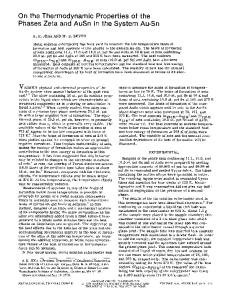Activities in the spinel solid solution, phase equilibria and thermodynamic properties of ternary phases in the system C
- PDF / 911,617 Bytes
- 10 Pages / 603 x 783 pts Page_size
- 56 Downloads / 427 Views
TRANSACTIONSB
Yund and Kullerud7 have conducted the f i r s t extensive phase d i a g r a m investigation of this system at temperatures below 800°C by X - r a y and metallographic examination of the equilibrated phases contained in evacuated s i l i c a capsules. They identified two ternary phases, delafossite (CuFeO2) and cupric f e r r i t e (CuFe204), in addition to the stable phases in the binary systems Cu-O and F e - O . T h e r e was no evidence of a solid solution between the spinel phases CuFe204 and Fe304. Another systematic investigation of phase relations was c a r r i e d out by Gadalla and White,s who measured the loss in weight of mixtures of CuO + Fe203 on heating from 800 to 1500°C, under oxygen partial pressures of 0.21 t o 1 atm. They found increasing solid solubility between the two spinel phases CuFe204 and Fe304 with increasing temperature. More r e c e n t work by Schaefer e t a l ,9 in the temperature r a n g e 900 to 977°C and the oxygen partial pressure r a n g e from 10-4 to 0.5 atm, support the finding of solid solubility between the spinel phases. A new compound of the composition Cu6Fe3OT, postulated by Gadalla and Whites to replace the compound d e l a fossite, has not been identified by subsequent investigators .9,16 ~18,2o,23,29 The structure of CuFeO2 is rhombohedral with a = 5.96/~ and ot = 29 deg 6 min; or in the hexagonal description a = 3.03A, c = 17.09,~. The iron has octah e d r a l coordination, while copper has a l i n e a r twofold oxygen coordination like in Cu20. The oxygen is surrounded by a tetrahedron of t h r e e iron and one copper .lo Pabst has a r g u e d on the b a s i s of crystal ionic radii, and D e l o r m e and Bertaut 11 have a r g u e d on the basis of an electrostatic calculation of the lattice energy that the iron in delafossite is present in the trivalent s t a t e and the copper in the monovalent s t a t e (Cu÷Fe3÷O~-). Muir and Wiedersich12 have confirmed this valency assignment by Moesshauer studies. JefVOLUME 8B, SEPTEMBER 1977-451
ferson la has shown that the lattice parameter of CuFe204-Fe304 spinel solid solutions shows a m a x i mum and the C u r i e temperature shows a minimum at the equimolar composition (Cuo.sFe2.504). For this r e a s o n some r e s e a r c h e r s~4'15 have uncritically c h a r acterized this composition as a separate compound (CuFe5Os). As the iron concentration increases in the spinel solid solution, the Seebeck coefficient changes from positive t o negative values at Cuo.775Fe2.22504.13 It was suggested that the equilibrium Cu÷ + F e 3÷~ Cue* + F e ~
[1]
lies t o the left up to this composition; at higher concentrations of iron some F e2+ ions a r e present to control the conduction mechanism. ~3 Recently Cervinka and Sim§a~6 have determined the distribution of copper and iron a m o n g the tetrahedral and octahedral sites in the spinel of the composition Cuo.sFe2.~O4 by X - r a y diffraction. Further, b a s e d on t h e i r~6 saturation magnetization measurements, site preference e n e r gies of cations and the Nee
Data Loading...











